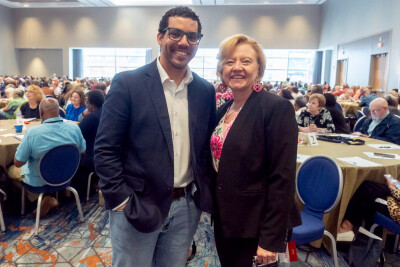Laity explore attracting new generations to church
 Amelia Duroska, the new Lay Leader of the Baltimore-Washington Conference, gathered more than 600 lay members for worship, fellowship, and learning on May 13.
Amelia Duroska, the new Lay Leader of the Baltimore-Washington Conference, gathered more than 600 lay members for worship, fellowship, and learning on May 13.
The laity were seated with members of their new Hubs to begin building relationships and to begin exploring the possibilities before them.
Bishop LaTrelle Easterling opened the session with prayer, praising the lay people for being the backbone of the Baltimore-Washington Conference and The United Methodist Church. “Without you, we couldn’t do or be what God has called us to do or be,” she said.
The bishop called on them to commit themselves even more deeply to “God’s will and God’s way.”
As the churches of the Conference continue to pursue and embrace vitality, Duroska introduced the Rev. Kris Sledge, pastor of the Journey UMC in Harrisburg, Pa., and the author of Followers Under 40: The Journey Away From Church for Millennials, Gen Z and Gen Alpha.
Sledge outlined several realities facing the church that he said would help them address the absence of younger people in their congregations.
In the United States, 17 percent of Americans are over 65 years old, while 42 percent of Protestants are over 65.
Within The United Methodist Church, Sledge said, the age of members and clergy is rising. Only six percent of United Methodist clergy are under 35.
In addition to the greying of the denomination, the church is also shrinking in size. Average attendance in United Methodist churches is 65. Seventy percent of churches have fewer than 100 people in attendance.
While there is no “silver bullet” to attracting young people into church, Sledge encourages churches to learn more about the unique culture inherent in each generation, from the Silent Generation to Generation Beta.
Many people in Generation X and Generation Alpha are very spiritual, he said, but they don’t feel compelled to attend traditional church at a traditional time on Sunday mornings. They question if church leaders value the same things they do, and if the church has any real impact on their daily lives.
However, if the church is willing to reach out in new ways and to take risks, it can attract young people into the congregation, Sledge said.
The four words that describe younger people in relation to church, Sledge said, are: curious, diverse, flexible, and unbundled.
“There are things that need to die in our churches so something new can be born,” Sledge said. “We need to trust that God is a God of resurrection.”
Sledge encouraged the laity to consider three questions as they go back to their churches.
- What are we willing to let die for the sake of connecting with new young adults?
- Which of the core values (belonging, safety, curiosity, diversity) is your church willing to embrace and where is there room to grow?
- What might resurrection look like in your ministry context?
